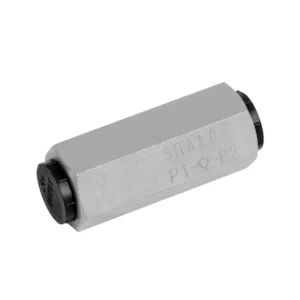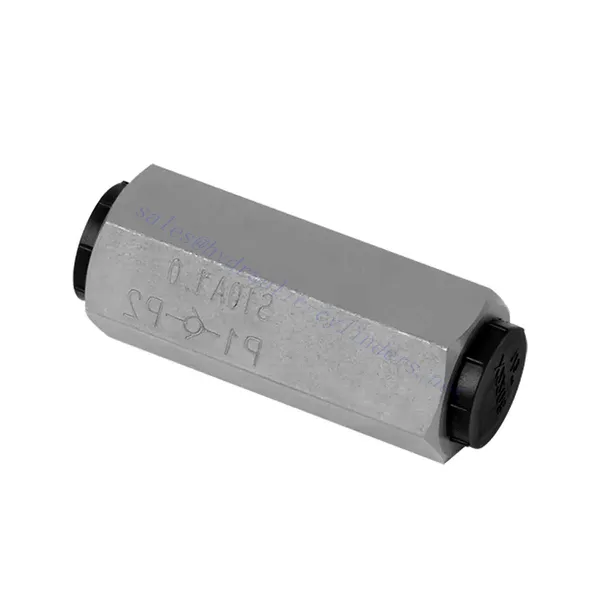S Series Check Hydraulic Valve
Jako jeden z producentów, dostawców i eksporterów produktów mechanicznych, oferujemy cylindry hydrauliczne i wiele innych produktów.
Prosimy o kontakt w celu uzyskania szczegółowych informacji.
Poczta:sales@hydraulic-cylinders.net
Producent dostawca eksporter siłowników hydraulicznych.
S Series Check Hydraulic Valve

The S series check hydraulic valve is a cutting-edge solution designed to enhance the performance and reliability of hydraulic systems. With its exceptional design and advanced features, this valve is poised to optimize fluid control and ensure efficient operation.
The S series check hydraulic valve is an indispensable component for hydraulic systems, offering reliability, efficiency, and versatility. Its reliable check functionality, high flow capacity, and space-saving design optimize fluid control and enhance system performance. Following the recommended usage methods and adhering to regular maintenance practices, the s series check hydraulic valve will continue providing reliable and efficient operation. Upgrade your hydraulic system with the S series check hydraulic valve and experience the benefits of improved flow control and system reliability.
S Series Check Hydraulic Valve Key Characteristics:
- Reliable Check Functionality:
- The S series check hydraulic valve incorporates an aspring-loaded check mechanism for reliable fluid flow control.
- This feature ensures that the valve allows fluid to flow in one direction while preventing backflow in the opposite direction, maintaining system integrity and preventing potential damage.
- High Flow Capacity:
- The valve is designed to handle high flow rates, making it suitable for efficient and unrestricted fluid flow applications.
- Its optimized flow path minimizes pressure drop, enhancing system performance and reducing energy consumption.
- Compact and Space-Saving Design:
- The S series check hydraulic valve features a compact design, making it ideal for installations with limited space.
- Its streamlined design allows easy integration into hydraulic systems without compromising overall efficiency.
- Versatile Application:
- This hydraulic valve is suitable for various applications, including industrial machinery, agricultural equipment, construction machinery, and more.
- Its versatility makes it a reliable choice for various hydraulic system configurations.
S Series Check Hydraulic Valve Parameter:
| Size | 6 | 8 | 10 | 15 | 20 | 25 | 30 | 40 | |
| Max. flow-rate | L/min | 15 | 30 | 40 | 120 | 200 | 300 | 400 | 600 |
| Max. operating pressure | bar | 315 210(NPTF1 1/4 NPTF1 1/2) | |||||||
| Crack pressure | bar | 0.5; 1.5; 3; 5 | |||||||
| Fluid | Mineral oil; Phosphate ester | ||||||||
| Fluid temperature range | ℃ | -30 to +80 | |||||||
| Viscosity range | mm2/s | 2.8 to 500 | |||||||
| Degree of contamination | Maximum permissible degree of fluid contamination: Class 9. NAS 1638 or 20/18/15, ISO4406 | ||||||||
S Series Check Hydraulic Valve Advantages:
• Conical seat valve
• Sub-plate mounting
• Multiple levels of opening pressure
Usage Method Of S Series Check Hydraulic Valve:
- System Integration:
- Identify the appropriate location for the S series check hydraulic valve within the hydraulic system.
- Ensure compatibility with the system’s pressure and flow requirements.
- Install the valve in line with the fluid flow, considering the desired direction of flow and the need for check functionality.
- Proper Orientation:
- Pay attention to the directional arrows on the valve body indicating the preferred flow direction.
- Ensure that the valve is installed with the correct orientation to guarantee proper check functionality.
- Connection:
- Select compatible hydraulic fittings and hoses for secure and leak-free connections.
- Follow the manufacturer’s instructions for proper torque values during the installation process.
- Use appropriate thread sealants or tape to ensure a reliable seal.
- Testing and Operation:
- After installation, test the valve’s functionality by operating the hydraulic system.
- Observe the flow direction and check that the valve allows fluid to pass in the intended order while preventing backflow.
- Monitor the system for any abnormalities, such as leaks or pressure fluctuations, and address any issues promptly.
How To Replace Seals On A Hydraulic Cylinder?
Replacing seals on a hydraulic cylinder is an essential maintenance task to ensure the proper functioning of the cylinder. Here is a step-by-step guide on how to replace seals on a hydraulic cylinder:
- Safety Precautions:
- Prioritize safety by wearing appropriate personal protective equipment, including gloves and safety glasses.
- Make sure the hydraulic system is depressurized. Turn off the power source and relieve any residual pressure by operating the control valve several times.
- Cylinder Removal:
- Detach the hydraulic cylinder from the equipment or machinery. Depending on the specific setup, this may involve removing mounting bolts or pins.
- Support the cylinder during removal to prevent it from falling or causing damage.
- Cylinder Disassembly:
- Place the cylinder on a clean and stable work surface.
- Remove the cylinder head or cap using the appropriate tools, such as wrenches or sockets.
- Carefully slide out the piston and the piston rod from the cylinder barrel.
- Seal Identification:
- Identify the seals that need to be replaced. Common seals in a hydraulic cylinder include the piston, rod, and wiper seals.
- Consult the cylinder’s manual or seek guidance from the manufacturer to ensure you obtain the correct replacement seals.
- Seal Removal:
- Use a seal removal tool or a small flat-head screwdriver to carefully remove the old seals, taking care not to damage the cylinder surfaces.
- Pay attention to the seal grooves and remove any remaining pieces or debris.
- Cleaning and Inspection:
- Thoroughly clean all the disassembled components using a suitable solvent to remove dirt, debris, and old hydraulic fluid.
- Inspect the cylinder barrel, piston, piston rod, and other parts for signs of wear, scoring, pitting, or any other damage. Replace any damaged components.
- Seal Installation:
- Lubricate the new seals with hydraulic oil or a compatible seal lubricant. This helps with proper installation and prevents seal damage during assembly.
- Install the new seals into their grooves, ensuring they are properly seated and oriented according to the manufacturer’s instructions.
- Take care not to pinch or damage the seals during installation.
- Reassembly:
- Reinsert the piston and piston rod into the cylinder barrel, ensuring they are aligned correctly.
- Apply a thin layer of hydraulic oil to the cylinder bore, piston, and rod surfaces to facilitate smooth movement and reduce friction.
- Carefully thread the cylinder head or cap back onto the barrel, ensuring it is tightened to the manufacturer’s specified torque.
- Cylinder Installation:
- Reattach the hydraulic cylinder to the equipment or machinery, following the appropriate mounting procedures.
- Ensure all connections are secure and properly tightened.
- Verify that the cylinder is properly aligned and positioned for optimal operation.
- Testing and Inspection:
- Restore the hydraulic system’s pressure and check for any leaks around the replaced seals.
- Operate the cylinder through its full range of motion to ensure smooth operation.
- Monitor the cylinder for any abnormal noises, vibrations, or performance issues.
Możliwości i pojemność fabryki:
(1) Montaż
Dysponujemy najwyższej klasy niezależną platformą badawczo-rozwojową. Warsztat produkcji siłowników hydraulicznych posiada cztery półautomatyczne linie montażowe siłowników podnoszących i jedną automatyczną linię montażową siłowników przechyłu, o projektowanej rocznej zdolności produkcyjnej 1 miliona sztuk. Specjalny warsztat cylindrów jest wyposażony w różne specyfikacje półautomatycznego systemu montażu czyszczącego o projektowanej rocznej zdolności produkcyjnej 200 000 i wyposażony w słynny sprzęt do obróbki CNC, centrum obróbcze, specjalny sprzęt do precyzyjnej obróbki cylindrów, robot spawalniczy, automatyczna maszyna czyszcząca, automatyczna maszyna do montażu cylindrów i automatyczna linia produkcyjna do malowania. Istniejący krytyczny sprzęt składa się z ponad 300 zestawów. Optymalna alokacja i efektywne wykorzystanie zasobów sprzętowych zapewniają wymagania dotyczące dokładności produktów i spełniają potrzeby wysokiej jakości produktów.


(2) Obróbka
Warsztat obróbki skrawaniem jest wyposażony w niestandardowe centrum tokarskie z pochyloną szyną, centrum obróbcze, szybkobieżną honownicę, robota spawalniczego i inny powiązany sprzęt, który może obsługiwać przetwarzanie rur cylindrycznych o maksymalnej średnicy wewnętrznej 400 mm i maksymalnej długości 6 metrów.

(3) Spawanie

(4) Malowanie i powlekanie
Z małymi i średnimi automatycznymi liniami do powlekania farbami na bazie wody, w celu osiągnięcia automatycznego załadunku i rozładunku robota oraz automatycznego natryskiwania, wydajność projektowa 4000 sztuk na zmianę;
Posiadamy również półautomatyczną linię do produkcji farb do dużych cylindrów napędzaną łańcuchem napędowym, o wydajności 60 skrzyń na zmianę.


(5) Testowanie
Dysponujemy najwyższej klasy urządzeniami kontrolnymi i stanowiskami testowymi, aby zapewnić, że wydajność cylindra spełnia wymagania.

We are one of the best hydraulic cylinder manufacturers. We can offer comprehensive hydraulic cylinders. We also provide corresponding przekładnie rolnicze. Eksportowaliśmy nasze produkty do klientów na całym świecie i zdobyliśmy dobrą reputację dzięki najwyższej jakości produktów i usług posprzedażnych. Zapraszamy klientów w kraju i za granicą do kontaktu z nami w celu negocjacji biznesowych, wymiany informacji i współpracować z nami!
Zapraszamy na wycieczkę po naszej fabryce VR:
Wybierz się na wycieczkę po naszej fabryce VR z następującymi elementami
Siłownik hydrauliczny Zastosowanie:


